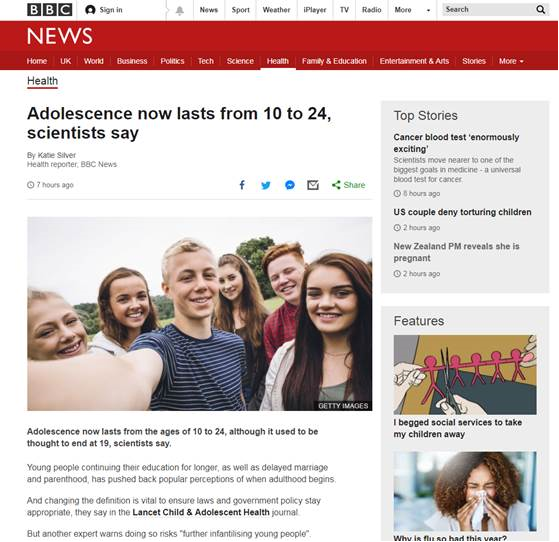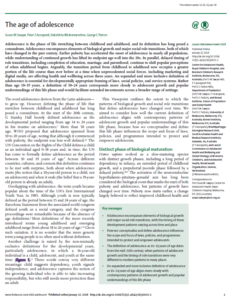The Age of Adolescence
Over the past few years, increasing numbers of papers of global relevance to adolescent health span the 10-24 year age group (see references 1-3 below for examples). Within the 2016 Lancet Commission on Adolescent Health and Wellbeing (4), we replicated this approach, and presented most data in three 5-year age bands (10-14 years, 15-19 years, 20-24 years). Given that the formal definition of adolescence is 10-19 years, I had expected we might be challenged about our expanded definition of contemporary adolescence. But, notwithstanding the huge media interest in the Lancet Commission, there was no interest in why we chose the 10-24 year age span and no interest in why we called it adolescence.
I found this surprising as whenever I talk about this to medical students, parents, policymakers, or the press, I am commonly met with surprise about when adolescence starts (“surely 10 year olds aren’t yet adolescents!”) and when it ends (“but 21 yr olds are adults, not adolescents!”). There seemed confusion around both childhood and adolescence. Some people prefer different terms (eg school aged children, youth, young people) and different age ranges have been applied to the same as well as different terms (see figure from the paper ‘The Age of Adolescence’).
So, in the context of a new Global Strategy for Women’s, Children’s and Adolescents’ Health, I felt there was value in in trying to articulate that how we conceptualise and define adolescence is important. Published in the Lancet Child and Adolescent Health on January 17th 2018 (5), our key messages were:
- Adolescence encompasses elements of biological growth and major social role transitions, with the timing of these development patterns varying across time and place.
- How we conceptualise and define adolescence influences the scope and focus of laws, policies, and programmes intended to protect and empower adolescents.
- The definition of adolescence as 10–19 years of age dates from the mid-20th century, when patterns of adolescent growth and the timing of role transitions were very different to modern patterns in many places.
- An expanded and more inclusive definition of adolescence as 10–24 years of age aligns more closely with contemporary patterns of adolescent growth and popular understandings of this life phase.
 That night, as I was on my way to Melbourne’s Tullamarine airport to attend an academic meeting in London, I began to sense that one of my co-authors might be right. Commission Chair, George Patton had predicted media interest – and there was. First up, the BBC wanted an interview – in the next hour! Thanks to some fancy footwork through immigration and the Qantas lounge, I was able to engage in a highly combative interview with an English sociologist (who I don’t think had actually read the paper!). This combative story then ran on the BBC website the following day, by which time I was having my second BBC interview, this time in person at their London studios, which was much more relaxed (and where I enjoyed the WHO paraphernalia in the BBC lobby). Over the next few weeks never before have I done so many interviews in so many countries and with such a variety of programs (health, youth, education, media, lifestyle, etc). Everyone had an opinion, and while most were initially sceptical, they largely seemed to agree by the end of each interview.
That night, as I was on my way to Melbourne’s Tullamarine airport to attend an academic meeting in London, I began to sense that one of my co-authors might be right. Commission Chair, George Patton had predicted media interest – and there was. First up, the BBC wanted an interview – in the next hour! Thanks to some fancy footwork through immigration and the Qantas lounge, I was able to engage in a highly combative interview with an English sociologist (who I don’t think had actually read the paper!). This combative story then ran on the BBC website the following day, by which time I was having my second BBC interview, this time in person at their London studios, which was much more relaxed (and where I enjoyed the WHO paraphernalia in the BBC lobby). Over the next few weeks never before have I done so many interviews in so many countries and with such a variety of programs (health, youth, education, media, lifestyle, etc). Everyone had an opinion, and while most were initially sceptical, they largely seemed to agree by the end of each interview.
Four months later, the frequency of requests for copies of the paper has not abated. If anything it continues to grow. In October I will speak at the European regional meeting of the International Association of Adolescent Health on this topic, and also at the Australian Adolescent Health meeting. The World Health Organization is considering holding a meeting to debate whether the age of adolescence should be expanded.
Why such interest? No doubt there is uncertainty about ‘naming the age’, but arguably much more has changed beyond the timing and duration of adolescence. The health profile of adolescents the world over is rapidly – and dramatically – shifting; new investments in policies and programs to respond to this burden are urgently required. Perhaps what has most changed is the extent of appreciation of the significance of adolescence within the lifecourse (4,6). This knowledge results in a very different set of reasons to invest in adolescence. Beyond the health and wellbeing of adolescents themselves, it is their future health, and that of the next generation, that are also at stake.
Professor Susan Sawyer
Commissioner, Lancet Commission on adolescent health and wellbeing
President, International Association for Adolescent Health
Director, Centre for Adolescent Health, Royal Children’s Hospital
Geoff and Helen Handbury Chair of Adolescent Health, Department of Paediatrics, The University of Melbourne
Group Leader, Health Services Delivery for Adolescents, Murdoch Children’s Research Institute
@susansawyer01
References
- Patton GC, Coffey C, Sawyer SM, Viner RM, Haller D, Bose K, Vos T, Fergussan J, Mathers CD. Global patterns of mortality in young people: a systematic analysis of population health data. Lancet 2009;374:881-92.
- Sawyer SM, Afifi RA, Bearinger LH, Blakemore SJ, Dick B, Ezay A, Patton GC. Adolescence: a foundation for future health. The Lancet 2012;379 (9826):1630-1640.
- Patton GC, Coffey C, Cappa C, Currie D, Riley L, Gore F, Degenhardt L, Richardson D, Astone N, Sangowawa AO, Mokdad A. Health of the world’s adolescents: a synthesis of internationally comparable data. The Lancet. 2012 Apr 28;379(9826):1665-75.
- Patton GC, Sawyer SM, Santelli JS et al. Our future: a Lancet commission on adolescent health and wellbeing. Lancet 2016; 387(10036):2423-2478 http://dx.doi.org/10.1016/ S0140-6736(16)00579-1
- Sawyer SM, Azzopardi PS, Wickremarathne D, Patton GC. The age of adolescence. Lancet Child and Adolescent Health 2018;2:223–28 (doi/10.1016/S2352-4642(18)30022-1).
- Patton GC, Olsson CA, Skirbekk V, Saffery R, Wlodek ME, Azzopardi PS, Stonawski M, Rasmussen B, Spry E, Francis K, Bhutta ZA, Kassebaum NJ, Mokdad AH, Murray CJL, Prentice AM, Reavley N, Sheehan P, Sweeny K, Viner RM, Sawyer SM. Adolescence and the next generation. Nature 2018 (doi:10.1038/nature25759)


